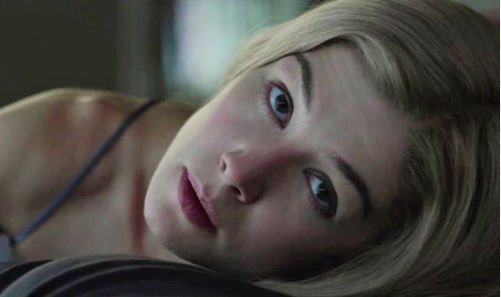
David Fincher’s Gone Girl is a haunting movie with a razor-sharp psychological thriller that masterfully explores the dark underbelly of marriage, media manipulation, and gender expectations. Based on Gillian Flynn’s best-selling novel, which also penned the screenplay for, the film unfolds like a slow-burning fuse—building suspense with icy precision until it explodes into a full-blown psychological war. What sets Gone Girl apart is its ability to balance style with substance, keeping audiences engaged through impeccable performances, tight editing, and unnerving aesthetics.
Rosamund Pike delivers a career-defining performance as Amy Dunne, a character as composed as she is terrifying. Her portrayal is both restrained and explosive, capturing the duality of a woman who is both victim and villain. Pike’s cold, deliberate delivery and expressive stillness allow her to command every frame she’s in. Ben Affleck, as the seemingly aloof husband Nick Dunne, gives one of his most natural performances, using his real-life public persona of smugness and detachment to amplify the character’s ambiguity. Their chemistry—or calculated lack thereof—creates a chilling emotional vacuum that enhances the tension. Supporting actors like Carrie Coon and Neil Patrick Harris round out the cast with nuanced performances that bring authenticity to the chaos.
From a director standpoint, David Fincher brings his signature clinical style, which works perfectly for this story of curated appearances and underlying rot. He doesn’t just tell a story—he dissects it. Every scene feels like a case file. Fincher’s commitment to emotional and visual consistency keeps the film grounded even when the plot veers into outrageous territory. He skillfully manipulates pacing and perspective, making the audience complicit in the characters’ lies and suspicions. The way Fincher captures media hysteria and public perception is both satirical and frighteningly real, blurring the line between entertainment and exploitation.
Cinematographer Jeff Cronenweth, a longtime Fincher collaborator, brings a subdued yet unsettling visual tone to the film. The use of cool, muted colors and strategic lighting emphasizes the emotional distance between characters. Flashback sequences are bathed in false warmth, highlighting how memory is often romanticized. The camera movement is minimal and precise, enhancing the psychological claustrophobia that defines the narrative. Rather than rely on flashy tricks, Cronenweth focuses on building atmosphere through shadows and silence.
The choreography and blocking in Gone Girl, though subtle, are meticulously designed to reinforce power dynamics. Scenes like Amy’s return home, where every move is calculated for the media’s gaze, feel almost balletic in their composition. Actors move with intent, and even the physical distance between them within the frame speaks volumes. There’s a choreography to the manipulation—a performance within the performance—that elevates the tension without overt exposition.
The editing by Kirk Baxter is another cornerstone of the film’s brilliance. The film smoothly transitions between timelines and perspectives, maintaining clarity while gradually peeling back layers of deception. The midpoint twist is delivered with such precision that it leaves the viewer stunned, recontextualizing everything that came before. Baxter’s cuts are deliberate—never rushed—allowing each scene to simmer with tension. Even scenes without dialogue hum with dread, thanks to perfectly timed transitions and reactions.
Production design by Donald Graham Burt deserves praise for how it supports the film’s themes. The Dunne household is tastefully empty, reflecting the lifeless marriage it houses. Desi’s lake house is a sterile prison dressed in affluence, visually symbolizing Amy’s entrapment and control. Every location, prop, and costume reinforces the characters’ psychological states and the false images they present to the world.
The score, composed by Trent Reznor and Atticus Ross, is an eerie blend of ambient soundscapes and synthetic unease. It lingers under the surface like a bad thought you can’t shake. Instead of overpowering the narrative, the music subtly amplifies discomfort, reinforcing the illusion of calm masking chaos. It’s a perfect match for a story that thrives on hidden darkness.
Finally, the production team, including Reese Witherspoon as a co-producer, deserves commendation for green-lighting a film that is as intellectually provocative as it is commercially viable. In an industry often dominated by formulaic storytelling, Gone Girl is bold, unsettling, and unapologetically dark. It doesn’t spoon-feed morality or resolution but instead forces viewers to wrestle with uncomfortable truths.
In conclusion, Gone Girl is not just a gripping thriller; it’s a cinematic dissection of marriage, identity, and media obsession. Every department—from acting and direction to production and sound—works in chilling harmony to create a story that stays with you long after the credits roll. It’s a landmark film that redefined the modern mystery genre and reaffirmed Fincher’s place as a master of psychological storytelling.
All over, I would like to give it a rating of 9/10.
Keep Reading Flickbites for the latest movie reviews.
